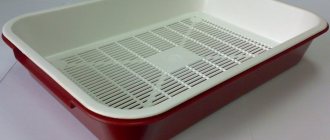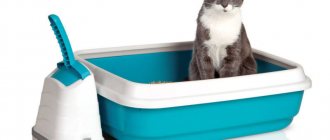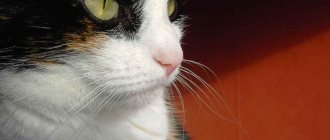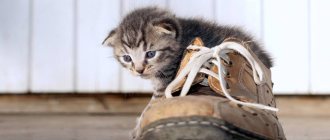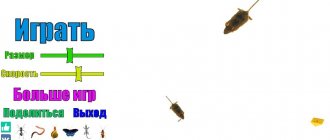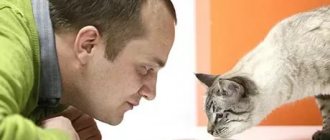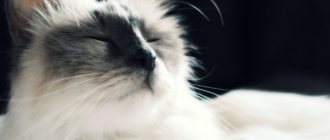Types of fillers
The most common cat litters include:
- Woody
- Mineral
- Silica gel
Woody
The wood filler is ordinary pressed sawdust with the addition of odor-eliminating flavorings. The advantages are low cost, environmental friendliness, ease of use, no toxic substances during production. Requires constant updating and throwing away the old one; an unpleasant odor may appear after four to five days. When moisture gets on the wood filler, it crumbles, but then when it dries, it forms a rather sweaty lump.
If you choose wood filler, it is better to choose one without aromatic additives. The smell of pine needles, pine, and fruit trees is itself a natural odor absorber, and animals will perceive them better. The combination of pine shavings and fruit flavors under the influence of cat urine often creates a sickening “aroma.”
Total possibility of flushing into the toilet:
- Wood pellets made from pressed sawdust get soaked quite quickly when they get into water. In any case, this is true for most fillers of the middle and low price category, made with minimal addition of impregnations.
- This property allows you to safely flush small portions of granular sawdust down the toilet: if the wood does not have time to swell and crumple before it ends up in the sewer or septic tank, then there will be no problems.
- At the same time, trying to empty the entire tray at once and wash it off in one go is practically doomed to failure. A few liters of water from the tank is clearly not enough to remove a large volume of sawdust, and while the container is being filled again, the material will have time to form a fairly dense plug.
Mineral
It is made on the basis of the mineral components of bentonite clay and other components (zeolite, vermiculite) with high moisture absorption capacity.
Their main difference and advantage is their high adsorption ability to absorb large amounts of liquid without leaving an odor.
Flushable toilet, mineral cat litter:
- The difference between mineral filler and wood filler is that it clumps almost instantly. On the one hand, this is an advantage when using the material for its intended purpose, but on the other hand, it becomes a frequent cause of blockages.
- This is why bentonite granules should only be thrown into the toilet in very small quantities . Actually, owners of frequency cats do just that: they picked out fresh lumps with a scoop, washed them down the drain, and added a new portion to the tray.
- If you pour the entire contents of the tray down the drain, then a blockage in the toilet is almost guaranteed. And even if you manage to quickly wash away the clay with a stream of water, somewhere below it will definitely find an elbow or a bend in the pipe and form a blockage, which will be very difficult to destroy.
Silica gel
Excellent modern practical material, requires replacement every 3-4 weeks. Eliminates odors completely. Its main drawback is its high price, so it is not so widespread.
All litter materials are successfully disposed of in the trash without causing an environmental disaster, but some want to take the easy route by flushing cat litter down the toilet. Moreover, on some packaging of wood filler it is written that it can be flushed down the toilet.
- Silica gel in trays is used in fairly small quantities: it absorbs liquids and odors quite well, so there is no need to add a lot of filler.
- At the same time, the discussion “If you use silica gel filler, is it possible to flush large volumes of it down the toilet?” are ongoing. This is due to the declared danger of the material for the environment.
- In fact, the substance that is used to adsorb cat waste is chemically inert. So the main danger is not the release of toxins into the water or soil, but the swelling of the granules. If you pour out a lot at once, a blockage will form not in the toilet, but in the pipes located below, and it will be almost impossible to remove it.
Video: Comparison of fillers
Classification
There is only one correct answer to the question: “Is it possible to flush cat litter down the toilet?” It all depends on what material the filling is made of. As already mentioned, any type of it can cause problems with the patency of sewer pipes, but some materials tolerate flushing better, while others - worse. Let's take a closer look at the most common options.
Woody
For its production, pressed sawdust is used, sometimes with aromatic impregnations. When moistened, the wood first flakes and then comes together in clumps. The advantages of wood fillers include:
- Relatively low price.
- Ecological cleanliness, absence of substances harmful to health.
- Easy to dispose of (it’s much easier to get rid of it).
Disadvantages include the need for frequent replacement. If you do not replace the litter box in time, then after 4-5 days you will begin to be bothered by unpleasant “odors” from the cat’s litter box.
Important! Practice shows that it is better to buy fillers without flavors. Fruit tree shavings have a natural, pleasant odor and mask stool odors well. Artificial fragrances, on the contrary, form an unbearably sickening “amber” with cat urine. In addition, the smell of citrus fruits repels the animal.
Mineral
The basis of the mineral filler (for example, katsan) is bentonite clay, as well as other substances with good absorption capacity (vermiculite, zeolite). When wet, the mixture clumps and can be easily removed using a special scoop.
Important! The main advantage of clay materials is that they not only absorb liquid well, but also absorb odors.
Silica gel
This is the most modern and practical option, the only drawback of which is the relatively high cost. You can change such consumables once every 2-3 weeks, there is practically no unpleasant smell. But it is not advisable to use this filler for kittens, since they chew the granules, and this can harm the baby’s health.
Paper
Unfortunately, paper-based filler is rarely found in retail sales. Japanese products are considered the best here. It can be found on the websites of special online stores selling Japanese pet products. There is only one drawback - the high price.
Vegetable
Like paper, vegetable litter (such as corn) can be disposed of down the drain. But, unfortunately, this is where their advantages end. Next come the downsides:
- The filler is lightweight, which means it spreads throughout the apartment.
- Doesn't neutralize odors well (2 days and an unbearable stench).
Important! This option can be used if the pet suffers from allergies to all other types of materials.
A separate type of vegetable fillers is based on soy fiber. Unlike corn, they have excellent performance qualities. The disadvantage is the same as with paper products - high price.
So what kind of cat litter can be flushed down the toilet?
In principle, it is possible to wash off wood filler, but it is highly undesirable to do so. You need to wash it off a little, in small portions, each portion no earlier than half an hour later. If you flush it down the toilet, you do so at your own risk, as clogged sewer pipes can cost you more. Wood filler dissolves and can circulate through the sewer system, but if there is wear on the sewer, blockage of joints and bends, which weakens the pressure of the drain, this filler, when dried, creates additional blockage leading to repair and cleaning of the pipes.
The most correct and safest way is to throw it in a solid waste bin and not fall for the marketing tricks of filler manufacturers.
Methods for removing blockages
Mechanical pipe punching
If trouble does occur, and as a result of a large amount of filler getting into the sewer system, it is necessary to take action.
You can deal with blockages like this:
- If the incident has just happened, and the bulk of the material is in the toilet itself, you need to remove it from there as quickly as possible. To do this, we put a rubber glove on our hand and scoop out everything we can reach.
Advice! If you don't have gloves, you can wrap your hand in a plastic bag.
- After manually cleaning the toilet, you need to push the residue (there should be relatively little of it) into the pipe itself. To do this, install a plunger on the drain hole, press the rubber socket tightly to the surface and begin pumping, as during normal cleaning.
- To make the work more efficient, it is advisable to add a small amount of water to the toilet. However, do not overdo it - if the cork is very dense, then you will have to remove the water by scooping it out.
- When sawdust filler gets into the pipes, a plunger should be enough. But bentonite is capable of blocking the lumen “tightly”, so the plug will have to be destroyed mechanically.
- To do this, we use a cable with a special attachment, which we screw into the jam and destroy it. Our goal is to punch a hole in the center of the pipe, and then the flow of water will gradually wash away the contamination.
Why you shouldn’t flush mineral and silica gel litter down the toilet
In a matter of minutes, the mineral filler clumps into a lump, ending up in the sewer network. It is strictly forbidden to wash it off! If you try to wash it off in parts, then the problem may not occur for the time being, but if you wash it all off at once, then a blockage will be inevitable. Removing it will take a long time and not be easy. Do not wash off clumping litter!
Silica gel is used very sparingly, absorbing odors and moisture. Disposing of granules down the toilet drain will cause blockages deep in the sewer pipes, where they will swell, causing problems for you and your entire home. It will be impossible to remove such a blockage with a plunger or a sticker film.
Which to choose
Before choosing silica gel cat litter, you need to find out the manufacturers and what features their products have.
Types of silica gel fillers
There is a certain rating of silica gel litters for cat litter, which can be used to determine the quality of the product.
- Siberian cat. High quality, harmlessness, low price are the main advantages of mixtures produced by the Russian manufacturer.
- 1 crystals. Another Russian manufacturer that produces premium products. You can buy it at a reasonable price. Has antibacterial properties.
- Tailtail. Russian manufacturer producing two-color granules. It is odorless and does not stain your pet's paws.
With a wide range of cat litter mixtures to choose from, you can find one that is right for your cat. It is better to refrain from buying the cheapest compounds. They can harm your cat's health.
Silica gel fillers have high moisture absorption properties. However, it is better not to buy it for kittens to avoid problems with swallowing granules. Owners of furry pets need to carefully monitor the animal’s reaction to synthetic material. If used correctly, health problems can be avoided.
Did you like the article? Rate it and tell your friends!
What to do if the toilet is clogged with cat litter
If this problem happens and your toilet is clogged with cat litter, you can try to break through the blockage with a plunger or a plastic bottle, especially if the blockage is located nearby and not much.
Please note that toilet plungers are different from sink plungers.
If it was not possible to clean it in this way, a plumbing cable will come to the rescue, which eliminates most problems with clogged sewer pipes. A very convenient thing, it rolls up into a coil and does not require much storage space.
Methods for removing blockages
Mechanical pipe punching
If trouble does occur, and as a result of the ingress of a huge amount of filler the sewer system “rises,” measures need to be taken.
You can deal with blockages like this:
- If the incident has just happened, and the bulk of the material is in the toilet itself, it is necessary to remove it from there as quickly as possible. To do this, we put a rubber glove on our hand and scoop out everything we can reach.
Advice! If you don’t have gloves, you can wrap your hand in a plastic bag.
- After manually cleaning the toilet, you need to push the residue (there should be quite a bit of it) into the pipe itself. To do this, install a plunger on the drain hole, press the rubber socket well to the surface and begin pumping, as during simple cleaning.
Crystals Fresh Step filler
The cost for 1.81 kg is 999 rubles, in terms of 100 g – 55 rubles. 19 kopecks
The ingredients are not indicated on the package. At the very bottom of the package it modestly says “contains silica gel.” Made in China.
“One of the advantages” that the manufacturer claims is that it is easily sifted through a dustpan when cleaning, more pleasant for cat paws. This was especially touching. Apparently, during the survey, the respondents, that is, the cats, answered: “All fillers are disgusting for our paws, except for silica gel.”
Important! Silica gel fillers from any manufacturer (although we were told a terrible secret at the pet store that absolutely all silica gel fillers are produced at a single enterprise in China) cannot be flushed down the toilet!
The cost for 3.17 kg is 539 rubles, in terms of 100 g – 17 rubles.
Ingredients: clay, activated carbon, flavoring. Made in China.
From the advertisement on the packaging - it instantly neutralizes unpleasant odors. No other advantages of the filler are indicated.
Important! This filler, like all clay-based fillers, cannot be flushed down the toilet!
The second stage of our research was an absorbency test.
We poured 100 g of filler into five plastic plates and poured 200 g of water each.
Crystals Fresh Step and Extreme Fresh Step immediately dropped out of the battle for the main prize. They were unable to absorb 200 g of liquid.
The rest of the participants showed themselves to be "A" performers.
The Japanese blue with indicator turned blue and became crumpled so that it did not fall out even when the plate was turned over.
Our woody and Japanese corn also held up. The Japanese did it a little better. Not even all the filler granules were wet.
Our domestic one managed, but was very swollen.
Notes from a cat owner. I don’t know about everyone who uses similar litter, but my toilet grate rises a lot as I use it, and the contents spill out over the side, since the cat is always in one position. As a result, I have two wet corners and a dry middle of the toilet.
We measured out another 100 g of water and poured it into each of the three leading fillers. Everything survived, that is, 100 g of each filler absorbed 300 g of water.
We poured another 100 g each (for a total of 400 g) and at this stage “Our Cat” left the game (when turning the plate over, about 50 g of water flowed out).
We poured another 50 g of water into the remaining Japanese toilet fillers and the “Japanese blue” also gave up.
Since there were still dry granules left in the leader's plate, we took a chance and added another 50 g of water. The filler survived. (All the granules were saturated with moisture, but when turning the plate over, the water did not drain.) In total, the winner was able to absorb 500 g of water.
In addition to the absorbency test, we tested the fillers for odor retention. We brewed strong coffee and added it to each topping. In this test, wood filler and Japanese cornmeal filler turned out to be the best.
Final table
| Price per 100 g of filler | 100 g of filler retained | |
| 1. Japanese filler with meadow herbs | 38 rub. 42 kopecks | 500 g water |
| 2. Japanese filler with blue indicator | 38 rub. 34 kopecks | 450 g water |
| 3. "Our cat" | 4 rubles 93 kopecks | 350 g water |
| 4. Crystals Fresh Step | 55 rub. 19 kopecks | couldn't even hold 200g of water |
| 5. Extreme Fresh Step | 17 rub. | couldn't even hold 200g of water |
1. Don't buy silica gel fillers. They are very expensive, but do not retain moisture well.
2. If finances allow, choose Japanese fillers. They can also be flushed down the toilet.
3. The cheapest domestic wood filler showed good results and turned out to be 8 times cheaper than Japanese ones. True, you won’t be able to flush it down the toilet.
We suggest you familiarize yourself with How you can seal rubber boots
4. The most easily clumping (easy to remove from the tray and add fresh) turned out to be a Japanese filler made from cellulose with meadow grass.
What happens when wood filler is flushed down the drain?
The cost for 3 liters (1.5 kg) is 74 rubles, in terms of 100 g - 4 rubles 93 kopecks.
Composition: compressed pine wood without foreign impurities.
The text on the package tells us that “Our Cat” is a 100% environmentally friendly product, does not stick to paws, has a subtle natural pine aroma, is hypoallergenic, does not generate dust and is an excellent odor blocker.
By the way, it is produced in Yekaterinburg.
Important! Do not flush the litter down the toilet!
As the name suggests, this type of tray product is made from wood scraps. As a rule, sawdust serves as the raw material for filler. They are pressed and given the shape of granules. Various fragrances can also be added to them. The popular Cats Best litter belongs to this type of litter tray product for pets. It is produced in Europe from recycled wood materials.
The undeniable advantages of this type of cat litter are considered to be:
- environmental friendliness and naturalness;
- the absence of components that can provoke the development of allergies in a pet;
- low cost;
- ease of disposal.
Wood filler, fine and waste, can be flushed down the drain. However, you need to understand that even completely soaked and crumbled granules are wood and not a biological substance. In other words, you should not flush large volumes of litter down the toilet at a time. If you do this, you will hardly be able to avoid a blockage and calling a plumber.
Questions about whether wood filler can be flushed down the toilet and how to do it arise mainly due to ignorance of what happens when trash gets into the sewer.
As soon as the filler material is in water, it begins to swell. Already used wood pellets are no exception. They soften and swell to a pulp. It is this property that makes it possible to flush the material into the sewer. It also causes blockages.
When a small amount of filler is washed off, the softened sawdust easily passes through all the bends of the toilet and pipes into the collector. But if a large volume of wood dust is discharged into the sewer at a time, the amount of water from the tank is not enough to “push” the material into the general house drain.
Precautionary measures
It would seem, what are we talking about here? I removed the grille, washed it, and put it back. The filler was disposed of when it became dirty. I washed the tray and filled it with new granules. Everything is easy and simple.
Not so. This subsection should be read carefully by pregnant women.
During the period of pregnancy, if possible, protect yourself from washing the cat's litter box. If for some reason this is not possible, then take the following measures:
- put a mask on your face;
- on hands - rubber gloves;
- After cleaning the tray, wash your hands thoroughly with soap.
The last two points should be followed by all cat owners. Why come into contact with used filler and dirty grate once again?
2. Japanese vegetable filler with meadow herbs
The cost for 7 liters (2.6 kg) is 999 rubles, in terms of 100 g - 38 rubles. 42 kopecks
Ingredients: corn cake, antibacterial agent, citric acid, flavoring, plant extract.
One of the “chips” of this filler is that it is safe if ingested. That is, if your animal suddenly decides to eat it, then nothing will happen. In addition, this filler effectively eliminates odors, is hypoallergenic, does not generate dust, but most importantly, it can be flushed down the toilet!
Cost for 7 liters (2.65 kg) - 1016 rubles, in terms of 100 g - 38 rubles. 34 kopecks
Ingredients: starch, recycled paper, polymer, antibacterial agent.
This filler also eliminates odors, is hypoallergenic, does not generate dust, and also flushes down the toilet!
We suggest you familiarize yourself with How to quickly eliminate the smell of moonshine
